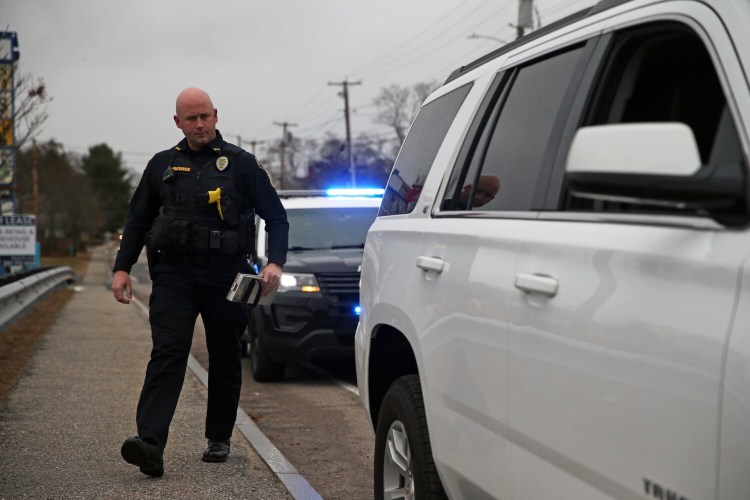BIDDEFORD — Detective Sgt. Steve Gorton could hardly keep up with what he was seeing.
Perched in an unmarked police vehicle near the Five Points intersection on a recent afternoon, Gorton watched as, one after another, drivers who were stopped in traffic reached for their cellphones, thumbs aflitter. As their gaze dropped from the roadway, Gorton picked up his radio.
A couple of blocks away, Officer Jacob Wolterbeek was positioned in a marked police cruiser along a side street. Wolterbeek hardly had to wait long.
“Black Honda Fit in the left lane,” Gorton said, calling out the license plate. “Yellowish-orange phone case. She had it below eye level, manipulating it with her thumbs.”
Since September, when it became illegal to handle a cellphone while driving, police agencies have been handing out tickets faster than analysts anticipated. But Gorton said he’s noticed how motorists act differently when they see a police car around. So the Biddeford department decided to try something different: It set up a sting.
And it found that plenty of motorists have not changed their habits.
The tactic requires more manpower and resources than allowing officers to write traffic summonses as they patrol normally in marked cruisers, but there are few other ways to get a clear idea of whether people are following the law when they think no one is watching.
“We wanted to get a true view of what’s going on at intersections,” Gorton said. “We want to look at a good, representative sample of the motoring public.”
The results were nearly instant.
So far in the roughly two-week enforcement push, Biddeford officers have written 83 tickets and observed about double that number of additional violations that officers couldn’t get to in time. The department had two marked vehicles to perform the traffic stops, Gorton said.
“That, quite frankly, that’s not enough,” he said, adding later, “It’s a target-rich environment.”
Using officers stationed in parked vehicles and working on foot in plainclothes, police have focused on busy intersections to spot cellphone violators as they idle at red lights. After Gorton calls out the violations, officers in marked cruisers chase down the offenders and write the summonses after the drivers pass through the massive intersection.
Wolterbeek, who is temporarily assigned to Gorton’s street crimes unit and has served with the department for 13 years, said he has seen his share of unnecessary crashes caused by distraction.
“A reasonable person in good weather doesn’t crash into the person in front of them unless something’s going on,” Wolterbeek said.
As he has assisted on the detail, Wolterbeek said he has watched people’s behavior shift in response to the law. Fewer folks hold the phones to their ears, but he still sees drivers who are obviously staring at something in their center console. And unlike other types of enforcement details, Wolterbeek said that drivers caught handling their phones seem to fess up when caught.
“When we say we have a plainclothes officer, they’re honest.”
When legislators passed the law this past summer, analysts predicted that police statewide would write 1,100 tickets before June 30, 2020, or 137 tickets per month.
In the first month after the new law took effect, police in Maine wrote 232 tickets, exceeding the legislative estimate.
In the first full fiscal year that ends June 30, 2021, it’s estimated that police statewide will write 5,500 citations, or about 458 tickets per month, worth an estimated $517,000 in new revenue that will supplement the state transportation budget and bring in an additional $82,700 in fees.
Police only need to see a cellphone in a driver’s hand to initiate a stop and write a $50 ticket for someone’s first offense. With added fees, the total amount due for first-time offenders who do not fight the ticket in court is $85.
Subsequent offenses are far steeper, at $325, including fees.
Drivers are allowed to interact with phones or electronic devices using a single push, tap or swipe, if the devices are secured to a mount or a cradle somewhere on the vehicle that does not interfere with the driver’s view of the roadway. Drivers are permitted and encouraged to use integrated hands-free calling systems or aftermarket Bluetooth devices to make and receive calls hands-free.
Caught in the enforcement sting last Wednesday was Diana Kandilakis of South Berwick. It was the day before Thanksgiving, and Kandilakis, 55, said she left work early so she could drive to Logan International Airport in Boston to pick up a relative for the holidays.
She was entering an address into her GPS app when an officer spotted her.
“It’s ironic, because I’m not a person who gets on my phone,” she said after stubbing out a cigarette. “It’s normally not an issue because I have Bluetooth.”
Comments are not available on this story.
Send questions/comments to the editors.



